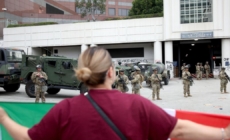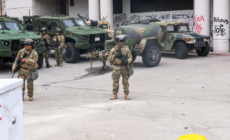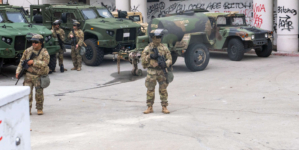-
Whose L.A. will prevail? Trump’s chaos or California officials’ vision of lawful protests? - 9 mins ago
-
Four Signs Your Dog Thinks of You as Its Parent - 14 mins ago
-
Kevin Hassett says if Senate finds Medicare abuse, then “we would look at it” in Trump bill - 16 mins ago
-
Spain's Mikel Oyarzabal finds the back of the net off a fast break vs. Portugal - 31 mins ago
-
What really happened outside the Paramount Home Depot? - 48 mins ago
-
Nuggets Trade Idea Lands Nikola Jokic Perfect Co-Star - 57 mins ago
-
Portugal's Nuno Medes scores equalizer vs. Spain - about 1 hour ago
-
The insurrection that wasn’t, and other Trump fantasies - about 1 hour ago
-
Escaped Zebra Captured, Airlifted After Week on the Loose - 2 hours ago
-
Spain vs. Portugal: UEFA Nations League Final updates, highlights - 2 hours ago
Iran and U.S. Threat of War: Five Things to Watch
Tensions have been running high between the United States and Iran, with U.S. President Donald Trump instituting a “maximum pressure” campaign against Tehran over its nuclear program and also launching air strikes against Iran-backed Houthis in Yemen.
Trump has said he would prefer a diplomatic solution to the standoff and sent a letter to the Islamic state’s leadership offering talks, but has not ruled out military action and U.S. forces have been building up their strength in the region. Iran has said there will not be direct talks while it is under pressure.
Here are five of the key things to watch:
Iran Response to Trump Letter
Iranian Foreign Minister Seyed Abbas Araghchi said Iran had responded to Trump’s letter. The letter outlines Iran’s views on the current situation following Trump’s message, which had been delivered via a UAE emissary on March 12. Trump had suggested opening negotiations for a new deal, after withdrawing from the previous nuclear agreement in 2018.
Araghchi emphasized that Iran would only engage in indirect talks while under U.S. “maximum pressure” and military threats. Supreme Leader Ayatollah Khamenei has reiterated that Iran refuses direct talks with the U.S., citing distrust in Washington’s commitment to agreements.
U.S. Navy/AP
U.S. Military Buildup
The U.S. is intensifying its military buildup at Diego Garcia airbase in the Indian Ocean amid rising tensions with Iran and ongoing strikes against Houthi forces in Yemen.
Open-source intelligence shows B-2 bombers and C-17 transport aircraft arriving at or heading to the base. Satellite images reveal additional deployments, including KC-135 refueling tankers.
The buildup points to increased readiness for large-scale regional air operations, with the U.S. linking Iran to Houthi attacks and warning against Iran’s nuclear ambitions. Iran says its nuclear program is peaceful.
Iran Continues Threats Against U.S.
Iran’s Parliament Speaker, Mohammad-Baqer Qalibaf, warned that U.S. military bases and allies in the region would be targeted if the U.S. launched attacks on Iran. His statement follows deadly U.S. airstrikes in Yemen and the rising tensions over Iran’s nuclear program.
Speaking on International Quds Day, Qalibaf rejected negotiations under threat, equating them to surrender. Iran has dismissed U.S. diplomatic overtures amid renewed sanctions and increasing military threats. Iran also recently conducted joint military drills with Russia and China in the Gulf of Oman.
Iran’s Economy Struggles
Iran’s currency, the rial, has plunged to a record low of 1,030,000 per U.S. dollar amid severe U.S. sanctions, stalled nuclear talks, and internal economic instability. Since President Masoud Pezeshkian took office, the rial has halved in value, inflation has surpassed 40 percent, and food prices have doubled. The crisis has worsened with declining oil revenues and new U.S. sanctions targeting covert Iranian oil exports.
The public, facing a deepening economic strain, is turning to gold and foreign currencies to safeguard their savings as uncertainty intensifies.
U.S. attacks on Houthis
Iranian-backed Houthi forces in Yemen announced plans to enhance their air defenses in response to ongoing U.S. airstrikes.
The move follows President Trump’s recent orders to target the Houthis after they threatened Red Sea shipping in solidarity with Hamas as it fights Israel in the Gaza Strip. The Houthis said they would soon be able to down advanced U.S. warplanes but gave no specifics. They also alleged attacks on the USS Harry S. Truman, though no damage was reported.
Source link































